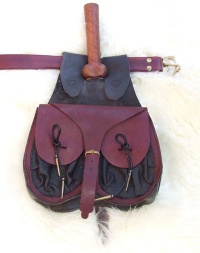Dagger: Difference between revisions
Paul Matisz (talk | contribs) No edit summary |
Paul Matisz (talk | contribs) mNo edit summary |
||
| (8 intermediate revisions by 3 users not shown) | |||
| Line 1: | Line 1: | ||
[[image:pouchdagger.jpg|right|200px|thumb|Replica 15th century pouch and bollock dagger.]] |
|||
| ⚫ | |||
A short pointed double-bladed [[knife]], commonly carried in period, as opposed to single-bladed knives like the medieval [[seax]] or the modern [[sgian dubh]]. |
|||
During the [[middle ages]] this [[weapon]] was primarily used in what some now refer as a ''reverse grip''. ie hilt up and point down. During the [[renaissance]] and later, the dagger came to be held point up in the manner of a [[knife]] except that the blade would be twisted in the hand so that the thumb rested against the flat of the [[blade]]. |
|||
Hilts of earlier daggers were simple and might be of the bollock type (having a [[guard]] that resemble testicles), [[rondel]] type or others. [[Renaissance]] dueling daggers might have curved quillions, broad hand guards, elaborate [[basket hilts]] or other furniture resembling a sword. These types of daggers have become commonly known as a [[Main Gauche]]. This basket hilt was placed slightly different to [[basket hilt]]s on [[sword]]s as the guard would often be symetrical and on the face of one side of the [[sword]] rather than the edge. |
|||
Blades varied (between times and cultures) to encompass from the ''stiletto'' -- thin and needle-shaped -- to the ''cinqueada'', almost five-fingers broad (hence the name) at the hilt, which reduces down to a point quite quickly; both of these weapons originated from [[Italy]]. |
|||
| ⚫ | |||
[[category:weapons]] |
[[category:weapons]] |
||
Latest revision as of 10:14, 12 July 2008
A short pointed double-bladed knife, commonly carried in period, as opposed to single-bladed knives like the medieval seax or the modern sgian dubh.
During the middle ages this weapon was primarily used in what some now refer as a reverse grip. ie hilt up and point down. During the renaissance and later, the dagger came to be held point up in the manner of a knife except that the blade would be twisted in the hand so that the thumb rested against the flat of the blade.
Hilts of earlier daggers were simple and might be of the bollock type (having a guard that resemble testicles), rondel type or others. Renaissance dueling daggers might have curved quillions, broad hand guards, elaborate basket hilts or other furniture resembling a sword. These types of daggers have become commonly known as a Main Gauche. This basket hilt was placed slightly different to basket hilts on swords as the guard would often be symetrical and on the face of one side of the sword rather than the edge.
Blades varied (between times and cultures) to encompass from the stiletto -- thin and needle-shaped -- to the cinqueada, almost five-fingers broad (hence the name) at the hilt, which reduces down to a point quite quickly; both of these weapons originated from Italy.
It was thought of by some as being a "poetic" weapon of choice for assassins.
